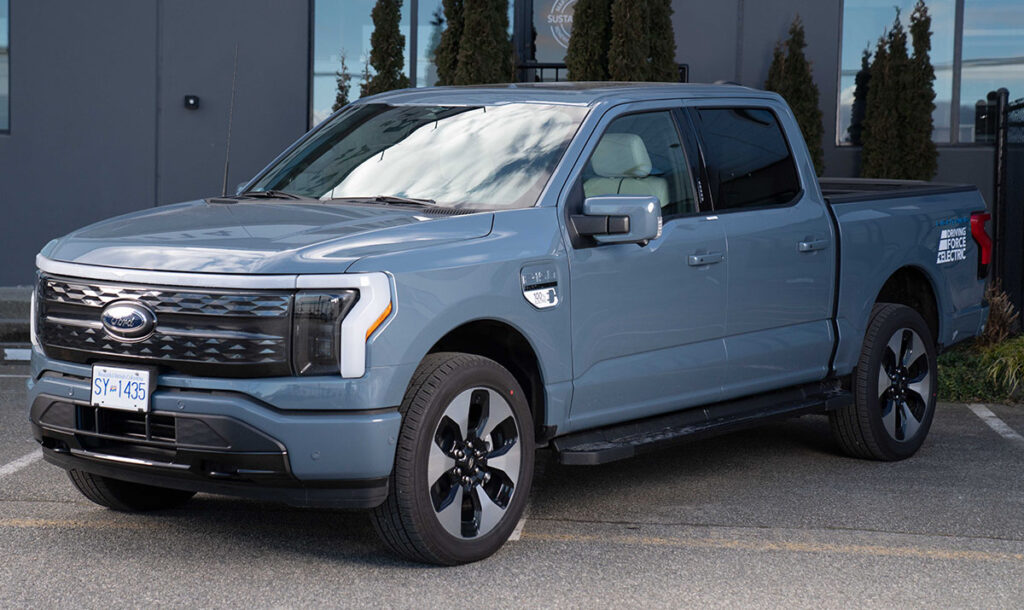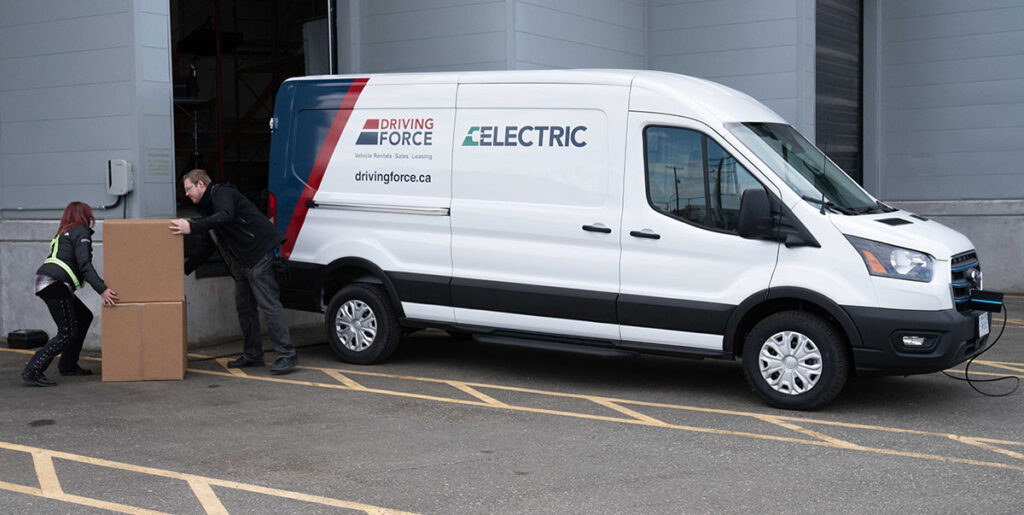Organization: Driving Force
Area served: Canada
Fleet size: 200+ EVs
Sector: Fleet Rentals and Leasing
Stage in electrifying fleet: Late-pilot stage
Vehicle types: Cars, pickup trucks, delivery vans, Class 6 trucks
Charging Infrastructure: Total of over 30 charging ports across Canada.

A Canada-wide EV program
Headquartered in Edmonton, Alberta, Driving Force is nearly two years into a large fleet electrification pilot involving some 200 electric vehicles across Canada. Deploying light- and medium-duty electric vehicles at their operations in British Columbia, Alberta and Ontario has allowed the national transportation and fleet management company to gather experience in a wide range of use-cases and climates, yielding significant learnings for Driving Force and their customers.
According to Mike Fisher, Senior Manager of Supply Chain and Logistics at Driving Force, this is just the beginning of a long process of finding out what vehicles work best in which situations. The Driving Force electrification project hinges on a large acquisition of electric vehicles from Ford – more than 100 Ford E-Transit vans, 50 Ford F-150 Lightning pickup trucks, and a dozen Ford Mustang Mach-E SUVs – allowing the team to consolidate their experience with a single manufacturer who could supply the number of vehicles they wanted.
Fisher, who joined Driving Force after a 30-year career at Ford, oversees the deployment of EVs across Driving Force operations.
“Success with fleet EVs is all about ensuring you’ve got the right infrastructure and you’ve got the right use-case,” he says.
For instance, use-cases that keep vehicles in constant motion – or, in winter, require the heater running all day long – might not be ideal for EV deployments right now, while use-cases with predictable routes, like courier activities, are better suited to EV operations and can benefit from overnight charging rates as low as 4¢ per kWh of electricity. Customers who fit this description and try one EV often end up acquiring a second vehicle, Fisher says.
The Driving Force customers who’ve been open to trying the EVs include short- to medium-term renters from the oil and gas industry, the film industry and municipalities. “We tend to recommend they get their feet wet with an F-150 Lightning,” says Fisher, “especially those who haven’t tried an EV pickup before.” It’s an easy way to introduce customers to the advantages the vehicles offer, such as additional storage and the ability to provide power from the battery pack for on-site uses.
Using on-site charging to optimize energy consumption
Driving Force chose Ford Pro charging infrastructure to fuel the E-Transit, F-150 Lightning and Mustang Mach-E vehicles acquired, and a combination of Level 2 and DC Fast Chargers were installed at several Driving Force locations in British Columbia, Alberta and Ontario. The chargers work with all the electric vehicles in Driving Force fleet (including Class 6 Lion Electric trucks) and enable optimized and automated charging schedules based on the needs of each vehicle.
“We can plug in the vehicles and basically say ‘I want all these charged by 6 a.m.’ – the system figures it out,” says Fisher. “In the morning, our vehicles are charged and ready to go based on the parameters we’ve put in.”
The Ford Pro software helps Driving Force manage electricity consumption by minimizing demand charges during peak hours and maximizing charging during low-rate periods. “There’s a compelling business case for anyone who does mostly city driving and charges at the low, overnight rates like in Ontario,” Fisher says. Vehicles managed in this way typically have fuel costs of about 7 percent what it costs to operate a comparable diesel-fuelled vehicle, he adds.

Deploying E-Transit vans and F-150 Lightning trucks in Northern Alberta
A big part of Driving Force’s process is learning from experience: trying vehicles in different situations and helping customers adapt to the new realities EVs bring. Northern Alberta temperatures dip as low as -40ºC, creating new challenges for EV drivers – challenges that Fisher and his Driving Force colleagues had to get to grips with before their customers.
“We’ve had to educate ourselves in order to educate our customers,” says Fisher.
He and other Driving Force employees have trialled the vehicles in their day-to-day duties and on specific trips to see how the vehicles perform, and to learn how to adjust habits to conserve battery power. “Education is something we have to do a better job with, collectively,” Fisher says.
One key learning was the need to precondition the vehicle cabin on cold days, which can save an important chunk of battery capacity for on-the-road uses. “Tips and tricks like this have helped me talk more than one customer off the ledge,” says Fisher.
Despite the challenges of winter operations in Alberta, there have been local success stories. The Ford Mustang Mach-E and Ford F-150 Lightning vehicles have proven to be reliable vehicles year-round, even if their range is greatest in warmer conditions. Fisher recalls one oil-and-gas customer who found the Ford F-150 Lightning to provide unexpected advantages in the open-pit setting. Because the battery enclosure seals the underside of the vehicle, bitumen couldn’t gunk up as many moving parts as on a gas-burning pickup truck.
Climate has a big say in where to deploy EVs
Based on Fisher’s experience, climate has a big impact on the use-case: “There’s a good reason the Prairies aren’t ground zero for EVs,” he says. For example, a Ford E-transit van with medium-roof trim has a book range of 190 km. For a fully-loaded van in the Edmonton winter – when battery packs can’t get to optimal temperature and the heater is always running – Fisher and his colleagues found the actual range to be 60–80 km with that payload.
The Greater Toronto area and British Columbia’s Lower Mainland, meanwhile, provide optimal conditions for EV deployment. But even in warmer, urban climates, persuading someone to try an electric van or pickup truck can be challenging.
“The people in the C-suite are all in,” says Ashton McHann, Business Development Manager at Driving Force’s Burlington, Ontario, location. “Convincing other people is where it can be complicated.”
A big part of McHann’s role is to identify companies that could benefit from operating EVs – and then make the case for electrification. The key to winning them over, McHann says, is that “seeing is believing” – even for companies that have a strong commitment to sustainability.

Electric vans create opportunities for zero-emission businesses
In 2022, Ashton McHann pitched the use of Ford E-Transit vans to a last-mile delivery company that delivers via e-bike in central Toronto. “We didn’t just have to convince them about EVs,” says McHann, “we had to persuade them to take on vehicles at all.”
This company, which describes itself as a “hyper-local logistics” business, operates an urban hub-and-spoke model as opposed to making point-to-point deliveries: parcels are gathered at one of two hubs (in east and west Toronto) where routing software determines the best route for each rider delivering packages to their destination.
After some discussions it was determined that a Ford E-Transit cargo van could simplify the transfers of parcels between the east and west hubs, from where the e-bikes complete the deliveries. Ultimately, what made the trial a success was a combo of the right vehicle fit and the delivery company’s desire to further optimize their business. In August, they added a second E-Transit van to their operations.
McHann points to the limited number of gas-powered delivery vans on the market as a factor in persuading more companies to try EVs. And Driving Force, through accrued experience and learning with their fleet of light- and medium-duty Ford vehicles, is in a unique position to guide companies through their first use-cases.